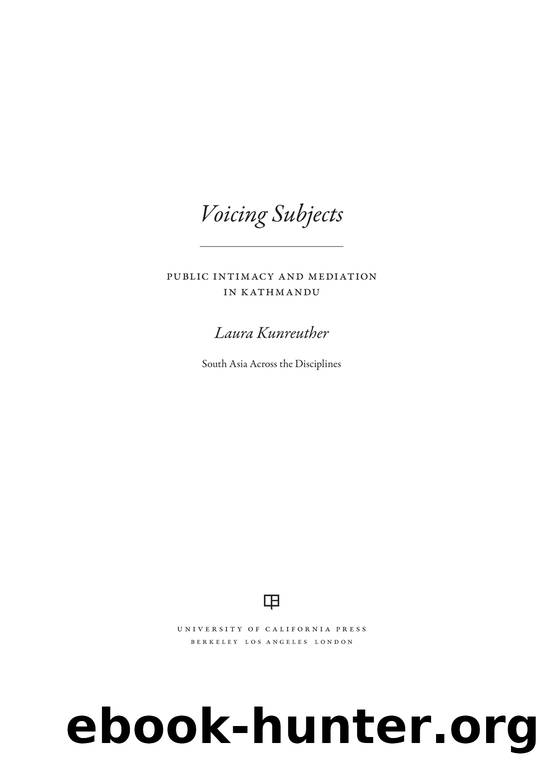Voicing Subjects: Public Intimacy and Mediation in Kathmandu by Laura Kunreuther

Author:Laura Kunreuther
Language: eng
Format: epub
ISBN: 9780520270688
Publisher: University of California Press
POLITICS OF AND POLITICS ON THE RADIO
On October 21, 2005, Nepali government officials attacked Kantipur FM, one of the oldest and largest commercial FM stations in Kathmandu. This attack took place eight months after King Gyanendra assumed sole control of the government, through an unprecedented control and censorship of media around the country, as described in the introduction. The government officialâs mission in the October attack was to seize satellite equipment that enabled the station to broadcast programs outside the Kathmandu Valley. This seizure was necessary, the Ministry of Information and Communication declared, because Kantipur FM refused to comply with a new government ordinance that forbid the transmission of programs in one location from another location and the broadcast of news (rather than âinformational programsâ). Put into place on October 9, 2005, the ordinance eerily evokes similar laws during the thirty-year royal regime of the PanchayÄt government (1950â90) that severely regulated the content of any media production.18 But given King Gyanendraâs coup nine months earlier (February 1), such state action against a private media house was not entirely surprising.
By this time, it had been four years (from 2001) since FM commercial stations were granted fully privatized licenses as well as the right to broadcast the news, a moment that many managers from the early days had eagerly awaited. FM programs were also broadcast throughout the country, either from small FM stations or, in the case of Kantipur, through programs produced in Kathmandu that were transmitted via satellite to smaller cities throughout Nepal. The wish to stop these transmissions was perhaps part of the old strategy of isolating the Valley from the rest of the country, which had been practiced by prior governments in Nepal.19 The government had worked hard to keep the Valley without full knowledge of the ongoing Maoist civil war, which was fought primarily in villages far from Kathmandu, but which continuously threatened to enter the Valley. Particularly after February 1, the government sought to isolate villagers from the antiroyal sentiment that had become, by this point, endemic in the Valley.
To protest the October 21 attack, journalists and media personnel gathered together with black cloths around their mouths to signify their stifled voices. The symbol of black cloths is a classic symbol of protest in Nepal (often worn around oneâs arm) and elsewhere, which allowed this protest to resonate clearly with other similar protests against censorship and governmental measures in general (see figure 2 in introduction). During the height of the jana Ändolan in 1990, for example, over two hundred writers and artists gathered silently in front of the Trichandra College, in the middle of Kathmandu, with black scarves tied around their faces to signify âhow they had been gagged by the governmentâ (Raeper and Hoftun 1992: 62).
After February 1, such protests again became commonplace, particularly among FM radio community. Prabhat Rimal, one of the managers of Kantipur FM, described two humorous protests staged particularly against the king, in what he called âmission journalism.â In one incident, media
Download
This site does not store any files on its server. We only index and link to content provided by other sites. Please contact the content providers to delete copyright contents if any and email us, we'll remove relevant links or contents immediately.
Cecilia; Or, Memoirs of an Heiress — Volume 1 by Fanny Burney(31351)
Cecilia; Or, Memoirs of an Heiress — Volume 3 by Fanny Burney(30949)
Cecilia; Or, Memoirs of an Heiress — Volume 2 by Fanny Burney(30907)
The Lost Art of Listening by Michael P. Nichols(6484)
We Need to Talk by Celeste Headlee(4881)
Asking the Right Questions: A Guide to Critical Thinking by M. Neil Browne & Stuart M. Keeley(4599)
On Writing A Memoir of the Craft by Stephen King(4221)
Dialogue by Robert McKee(3593)
I Have Something to Say: Mastering the Art of Public Speaking in an Age of Disconnection by John Bowe(3520)
Pre-Suasion: A Revolutionary Way to Influence and Persuade by Robert Cialdini(3422)
Elements of Style 2017 by Richard De A'Morelli(2946)
The Book of Human Emotions by Tiffany Watt Smith(2779)
Good Humor, Bad Taste: A Sociology of the Joke by Kuipers Giselinde(2559)
Name Book, The: Over 10,000 Names--Their Meanings, Origins, and Spiritual Significance by Astoria Dorothy(2498)
Fluent Forever: How to Learn Any Language Fast and Never Forget It by Gabriel Wyner(2451)
The Grammaring Guide to English Grammar with Exercises by Péter Simon(2397)
Why I Write by George Orwell(2362)
The Art Of Deception by Kevin Mitnick(2303)
Don't Sleep, There Are Snakes by Daniel L. Everett(2220)
